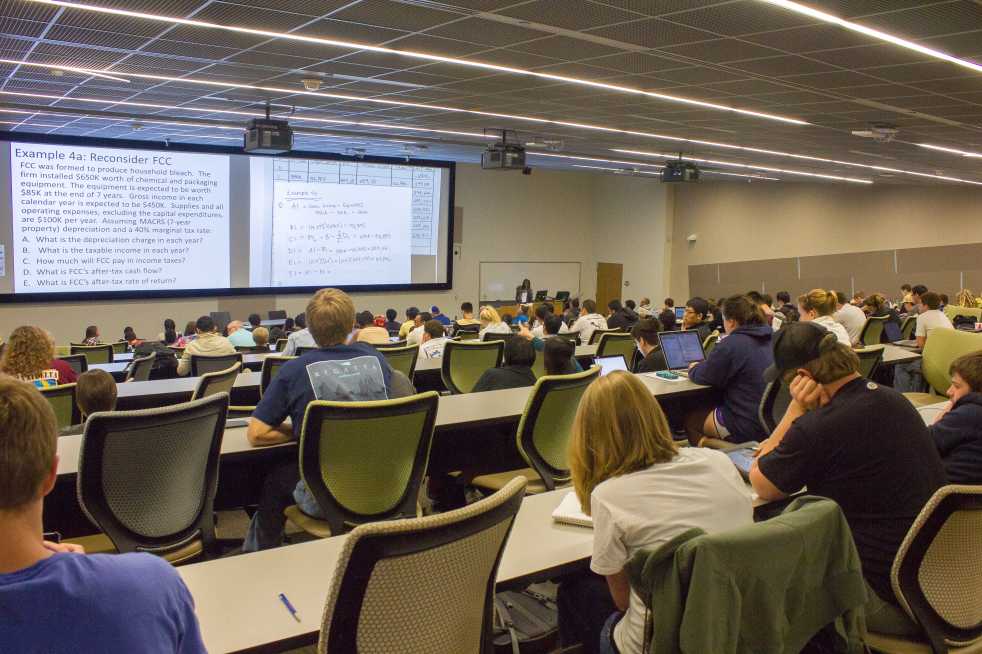Controlling the student-faculty ratio remains a challenge for the administration, especially with the current economic climate. Increasing the number of tenure-track faculty or decreasing the number of students can accomplish this.
“In addition to formulating recruitment strategies and hiring processes, the identification of funds to support this activity is forefront in the mind of every school chair, dean, the provost and president,” said Provost of the Institute Rafael Bras. “The Institute has been fortunate to have identified resources in this difficult time to maintain hiring and welcome new members to the faculty in the current academic year. Since [FY11], almost $13 million in new funds have been invested in tenured/tenure-track faculty hiring and retention at the Institute level.”
Despite these faculty increases, the student-faculty ratio has still been on the rise, with the full-time faculty enrollment increasing only by 6.8 percent since fall 2007 in contrast with a 15 percent increase in total enrollment.
The process to hire new faculty starts with the deans of each college identifying problem areas, such as having a higher load of students or dealing with the departure of current faculty. The recommendations are then discussed with the Provost, and decisions are made by the Provost to allocate the faculty lines to colleges.
“Typically, we replace 12 or 13 retirements each year, so the net [hiring additions] there is about 16,” said Dean of the College of Engineering Gary May.
However, hiring faculty may not be the clear solution to resolving the student faculty ratio – at least in the problem area of the college of engineering, where departments like BMED, ISyE and AE have the highest student-faculty ratios on campus, which are 62, 30 and 28, respectively.
“We can’t hire our way out of this because we can’t do that fast enough – the time scales are not compatible,” May said.
According to May, the rapid change in the trending majors is a major cause of greater care – which ultimately result in more scrutinous and fewer faculty hirings – taken towards hiring new faculty.
“If you go back 10 years before the dot-com bubble, electrical and compute engineering was the one that had 2000 undergraduates and not enough faculty. Now, we hire all these ECE faculty and now we only have 1300 undergraduates,” May said. “It’s kind of like we’re chasing a moving target. It would be nice if we can have a response time in our system that didn’t have so much lag in it.”
“We tend to separate that choice and balance this hiring by the student-faculty ratio as really a fire drill,” said Associate Dean of the College of Engineering John Leonard. “If we’re throwing the positions at where the fires are, that’s not very strategic. What we want to do is some anticipation of where the students are going to want to study so that when the student comes to Georgia Tech, their degree is relevant.”
Bras and May both acknowledged the additional need for space that new tenure-track faculty hires would require, which poses as an additional roadblock in easily hiring new faculty.
Enrollment Control
On the other hand, a smaller numerator can also decrease the student-faculty ratio. This means decreasing current enrollment, which can be controlled in front-end and transfer enrollment.
Enrollment, however, has continued to increase every year since fall 2007. Cutting down on enrollment may not be so easy.
“It’s certainly not out of the realm of possibilities, but it’s extremely unlikely – maybe even less unlikely in Ga. than other states,” said Vice Provost of Enrollment Services Paul Kohn. “Most states talk about enrollment being an underlying attribute of funding, so it’s a very difficult. It wouldn’t be suicidal for GT, but for other schools, a decision such as [cutting enrollment] would mean that they would probably have to lay people off, if not go out of business.”
According to Kohn, this decrease in enrollment has the potential to exacerbate the student-faculty ratio.
“There would be one point when [suppressed enrollment] would catch up to us and it would cost us millions, tens of millions dollars in state funding that we would lose,” Kohn said. “You’ll end up in the predicament where you have fewer commitments to faculty- you’re still carrying the fixed overhead costs of faculty…and you’ve forfeited a bunch of tuition dollars and caused the governors’ funding formula to allocate fewer dollars.”
“There are a lot of faculty members in engineering that would like to see us limit enrollment, particularly in those [problem] areas,” he said. “Right now, we’re not able to do that.”
Kohn instead offered other initiatives that Enrollment Services is undertaking to mitigate the student-faculty ratios in more problematic areas by shifting the student load to other areas.
“We started using these VIP landing pages,” Kohn said. “If you came to me and told me you really wanted to come here for chemical engineering, it would be a little awkward and strange if I turned around and told you about the benefits of being an architect. It’s a delicate balance, because I have to tell you what you want to know about chemical but I can also put in the background information you’re staring at in the video you’re watching that there are students here who are striving in other majors.”
Kohn also suggested that the 344 extra students admitted this freshman class was an anomaly that will not happen again.
“Last year, our admitted students really surprised us by accepting our offers at unprecedented higher rates than ever before,” Kohn said. “The plan was 2700. The plan for this coming fall is 2700. It will continue to be 2700.”
Transfer enrollment is able to be much more tightly regulated to offset larger front-end enrollment.
“We have made transfer admission more competitive so that when the freshman class of last semester reaches its junior year, my intentions are to offset most of that surge through the contraction in the number of students we accept,” Kohn said.
